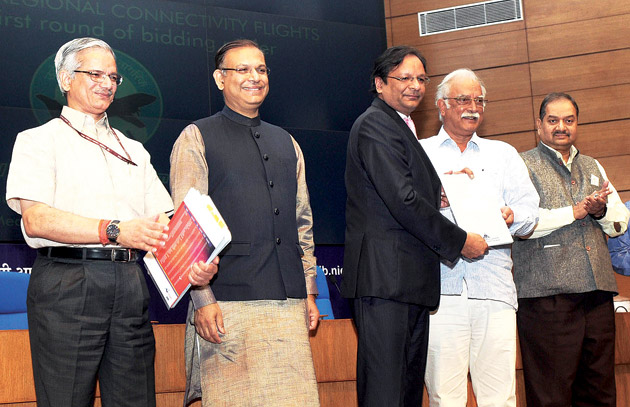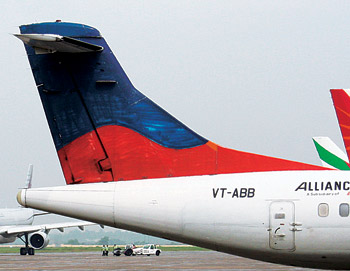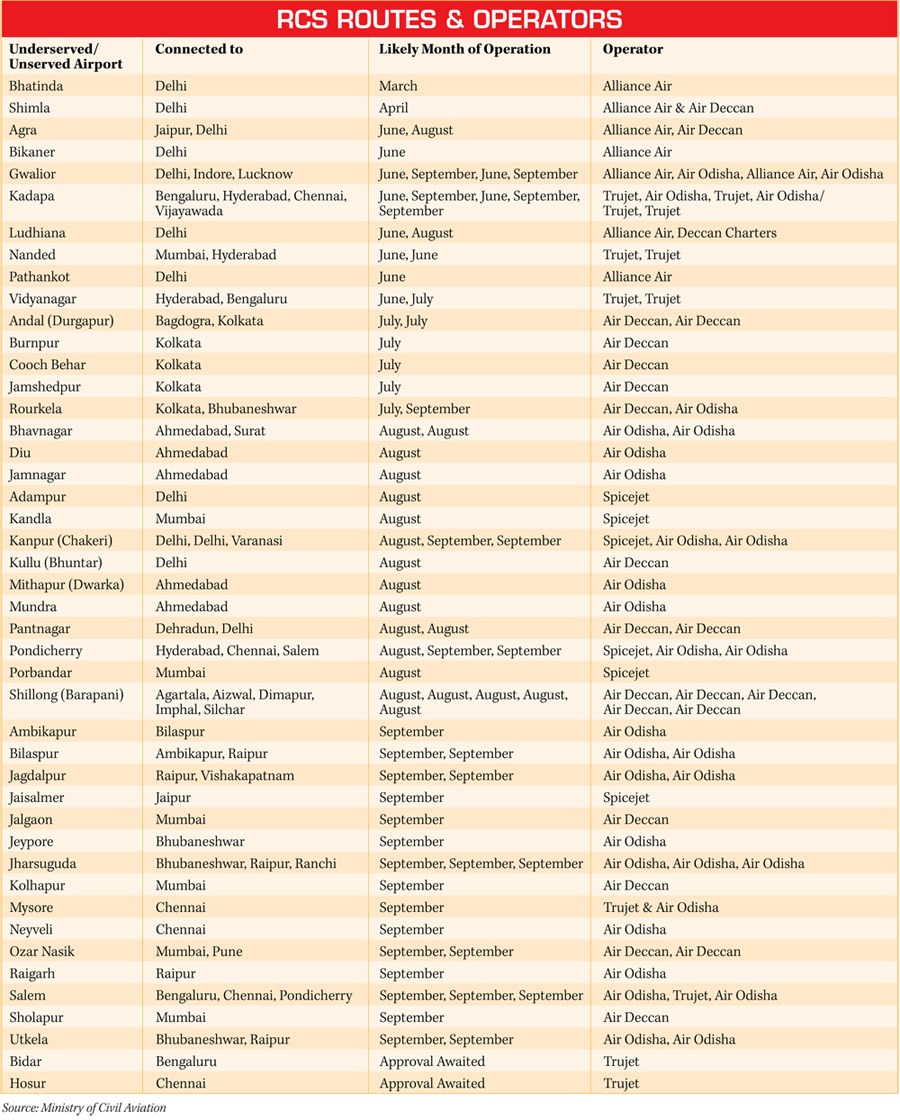70 Airports for UDAN
“The geographical spread of the airports covered is interesting.”

The Bharatiya Janata Party (BJP), which had promised in its election manifesto that it would work towards regional connectivity, has almost fulfilled that. The BJP-led National Democratic Alliance (NDA) government has taken a huge step in boosting regional connectivity through its Regional Connectivity Scheme (RCS) by awarding 128 regional routes to five airlines — Alliance Air, SpiceJet, Turbo Megha Airways (TruJet), Air Odisha and Air Deccan (Deccan Charters). Alliance Air is a subsidiary of state-owned Air India, and Ajay Singh-owned SpiceJet is a low-cost carrier; while TruJet is a regional airline and Air Odisha and Deccan Charters is a charter operators.
The NDA government’s lofty initiative ‘Ude Desh ka Aam Naagrik’ (UDAN) has been rolled out. The government unveiled the list of successful bidders and routes under the UDAN scheme which will make flying accessible and affordable to the common man. Commenting on the first round of RCS, Civil Aviation Minister P. Ashok Gajapathi Raju said, “The geographical spread of the airports covered is interesting.”
1.3 Million Seats Created
“This is a unique scheme, which is completely market-driven,” Jayant Sinha, Minister of State for Civil Aviation, said. “Through a corpus of only Rs. 205 crore, we will create around 1.3 million seats, which will kick-start the underdeveloped regional aviation market.”
Jayant Sinha said that the decision to award routes to the airlines was taken only after they gave bank guarantees for the routes. In the first round of RCS, Alliance Air has got 15 routes, which will see it touch five unserved and two underserved airports. Air Deccan has been awarded 34 routes, 10 at unserved airports and five at underserved airports. Air Odisha has won 50 routes. As many as 70 airports, including 31 unserved and 12 underserved ones, would be connected with the UDAN flights. The carriers will operate 19- to 78-seater aircraft.
These flights would connect airports spread across over 20 states and union territories including Punjab, Uttar Pradesh, Madhya Pradesh, Maharashtra, Andhra Pradesh, Gujarat, Himachal Pradesh, Karnataka, Tamil Nadu and Puducherry. The airports that would be connected under UDAN include Bhatinda, Shimla, Bilaspur, Neyveli, Cooch Behar, Nanded and Kadapa.
Civil Aviation Secretary Rajiv Nayan Choubey said that UDAN would leapfrog India’s aviation sector. “From a rate of one airport annually, we have leapfrogged to connecting 33 airports in a single year,” Choubey said, adding the routes have a uniform spread across the country.
THE GOVERNMENT IS LOOKING TO CREATE AN RCF OF Rs. 500 CRORE FOR VIABILITY GAP FUNDING OF 12 MONTHS AND ANY SHORTFALL WOULD BE MET BY AAI, WHICH WOULD BE LATER RECOVERED THROUGH A LEVY

The process saw intensive bidding for prime routes. For instance, SpiceJet outbid Alliance Air for the Delhi-Kanpur route, which Air India was operating till today. “It is a great day for Indian aviation,” said Amber Dubey, India head of aerospace & defence at global consultancy KPMG. “This will give a huge fillip to investments, tourism and job creation in the interiors of India. Good to see that the RCS routes are spread out across all corners of the country. Operators should try and synchronise their schedules and enter into code-share agreements with larger carriers.”
Flights under the RCS scheme could take off as early as April 2017 with both Alliance Air and Air Deccan indicating that they plan to launch services between Shimla and Delhi in April. Deccan Charters plans to operate Durgapur-Kolkata and Rourkela-Kolkata flights from July this year and launch flights linking Kullu to Delhi and Pantnagar to Dehradun in August. Air Odisha plans to link Bhavnagar to Ahmedabad and Diu to Ahmedabad in August, followed by flights between Kadapa and Bengaluru, Kadapa and Chennai, Rourkela and Bhubaneswar and Puducherry and Chennai among others. As a result, there will soon be Salem-Chennai, Kadapa-Chennai, Nanded-Hyderabad and Puducherry-Salem flights on which at least half the passengers will be able to fly at fares of under Rs. 2,500.
Ajay Singh, Chief Executive Officer, SpiceJet, said that the airline will induct three aircraft to participate in the RCS. SpiceJet’s plans include Puducherry-Hyderabad, Porbandar-Mumbai, Adampur-Delhi and Kandla-Mumbai services from August.
MoU with 16 State Governments
The Ministry of Civil Aviation (MoCA) had launched the RCS-UDAN on October 21, 2016, and had immediately commenced the e-bidding process to select airline operators for mounting RCS operations. The airfare cap under RCS-UDAN for fixed-wing aircraft ranges from Rs. 1,420 for 151 kilometres to Rs. 3,500 for above 800 kilometres. The Ministry has signed a memorandum of understanding (MoU) on RCS-UDAN with 16 state governments/union territories to provide concessions as mentioned in the RCS.
The UDAN scheme offers 50 per cent subsidy to airlines on these routes, route monopoly for three years and a host of other concessions at landing airports. It expects the airlines to cap fares at Rs. 2,500 a seat an hour rate on regional flights.
The scheme that would be funded through the Regional Connectivity Fund (RCF) created from levy of Rs. 7,500 and Rs. 8,500 charged to the airlines on a per-flight basis, could see unserved airports like Jaisalmer, Bikaner, Jalgaon, Akola, Kunj Vihar and others being connected through scheduled flights. To make it commercially viable for airlines to operate flights to these airports at fares capped at Rs. 2,500 for one-hour flight, the government has committed to cover any shortfall in operational cost through Viability Gap Funding (VGF) and has also offered a three-year exclusivity to airlines on the RCS routes. Besides these, it will also offer concessions on other services and tax relief on aviation turbine fuel (ATF) at underserved and unserved airports.
“As far as funding for UDAN is concerned, there are efficient ways of funding it. The proposal we have in front of levy to the airlines is the most efficient and least-cost way of funding, but if that poses challenges, then we have other mechanism too that we can use,” said the Minister. He said that his Ministry along with the Airports Authority of India (AAI), was behind UDAN and subsidies. “Those airlines that will be participating in UDAN can be sure that they will get the subsidies by way of VGF”. He said 15 states had already inked MoU with the Ministry for partnering in the RCS and another three will soon come on board.
The government is looking to create an RCF of Rs. 500 crore for VGF of 12 months and any shortfall would be met by AAI, which would be later recovered through a levy.
On the tussle with mainline carriers over levying regional connectivity charges, the Minister said: “We are very close to a solution over this matter. We had multiple rounds of discussion with the airlines and the issue will be resolved soon.” The Federation of Indian Airlines which consists of IndiGo, SpiceJet, Jet Airways and GoAir, and has around 80 per cent market share, had moved the court contesting that the government had no authority to impose a levy in the nature of tax on air services. Major airlines opposing the government’s move had put a question on VGF.






